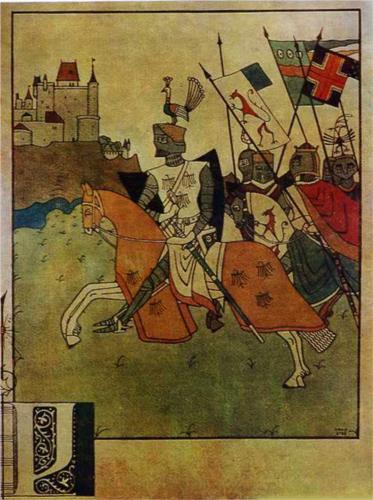Old School
On The Song of Roland

One of the striking fates of poetry over the last century has been the conflation of poem with lyric. But some of the most important poems for me have always been non-lyric genres: epigram; epistle; lais; 17th-Century French drama; et cetera. And, of course, the epic. One element that makes an epic decidedly poetic, to my mind, is its seemingly requisite scene of writing, which collapses materiality and signification so that inscription is undertaken as both the theme and the mode of the text. The Song of Roland, for one example, appears to allegorize the shift from oral to written traditions with the hero's refusal and abandonment of the breath-based olifant and his turn to a kind of degree-zero of inscription. In a fit of enraged frustration, Roland strikes a stone with his sword, unable to break his blade but marking the rock in the process:
Dedevant lui ad une perre byse .X. colps i fiert par doel e par rancune [....] Rollant ferit el perrun de sardónie [....] Rollant ferit en une perre bise,
Plus en abat que jo ne vos sai dire
[He lands ten blows on a dark rock in front of him, wounding it with sorrow and rage (….) Roland strikes the sardonyx stone (….) Roland strikes the dark rock, breaking off more than I can say].
All of the details matter: the rock is dark (either a shade of brown or grey, but in either case colored to better show marks from the steel); the rock is both sardonyx, a kind of chalcedony, as well as sardonic, grimly mocking Roland's futile strength; the ten blows are indicated by a Roman numeral that might serve as an icon visualizing the hacked sword slashes themselves; and the verb used to describe those blows brings together the sword's origins (fiere: made of iron) and its telos (ferit/fiert from ferir: to strike), with relevant echoes of bold arrogance (fieret/ fieror), ferocious and tragic violence (fier/ fierté), faithful duty (fier), and the tomb-like marble slab (fiertre) against which Roland is about to die. Moreover, ferit also denotes stamping or marking a coin (a kind of engraved writing) as well as wounding (directly from the Latin ferire), emphasizing the legible damage done by Roland's vandalism. The rock, in short, serves as a substrate for a text — however primitive and illiterate — that testifies simultaneously to Roland's heroic character and his inscriptive gestures — gestures that in the end do more than speech can (the figurative phrase is not incidental at this juncture: "plus […] que jo ne vos sai dire").
One could trace similar scenes in any number of epics and epyllia — from Tristram's carved signature in Marie de France's Chevrefoil to the engraved hilt of the sword given to Hrothgar in Beowulf all the way back to the opening lines of the Gilgamesh story: "sha naqba imuru [the one who saw everything]." The Akkadian word naqbu connotes totality, but it also signifies the depths or the deeps: either the source of subterranean wellsprings (key to a desert kingdom; central to an epic that will recount a great flood) or simply the interior of the earth — a pit or hole. The incipit thus suggests both the water and the soil that went to make the clay tablets on which the sentence was inscribed, and it specifically evokes the creviced canyons made by the scribe's stylus on a chthonic substrate. With its first cuneiform words, the epic seems to vertiginously magnify the scale of its tablet to planetary proportions, or else shrink the whole of the cavernous earth to fit in the palm of the hand.
Such moments may not be merely incidental, and I wonder if the epic — despite our received notions of its oral origins — is fundamentally linked with writing and the power of inscription. Does the dynamic mise-en-abîme opening of the Gilgamesh text capture something of the epic scale of writing itself: a system seemingly capable of describing everything (or, at the very least, of conveying the concept of totality) from a mere handful of marks and the most paltry materials: abrasions in mud; scuffs on the skins of dead ruminants; damp soot drawn on fragile pulped plant fibers. And furthermore, do epic narratives go on to allegorize the fate of poetry? Does Roland's final geste figure writing's hybris in the face of its erroneous wanderings and doomed failures, of the tragic inevitability that it will miss its mark — even when marking is only all that it ever does.


